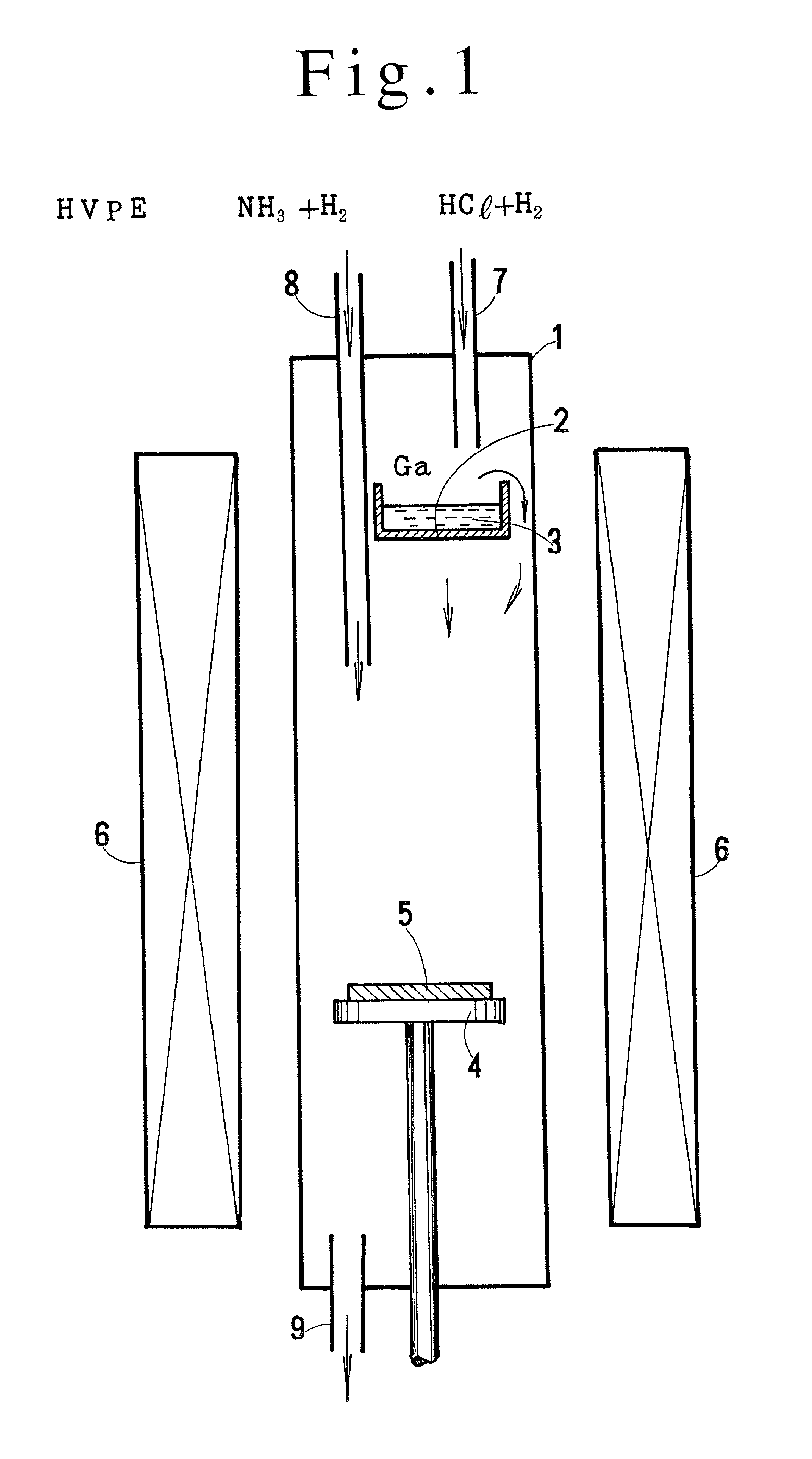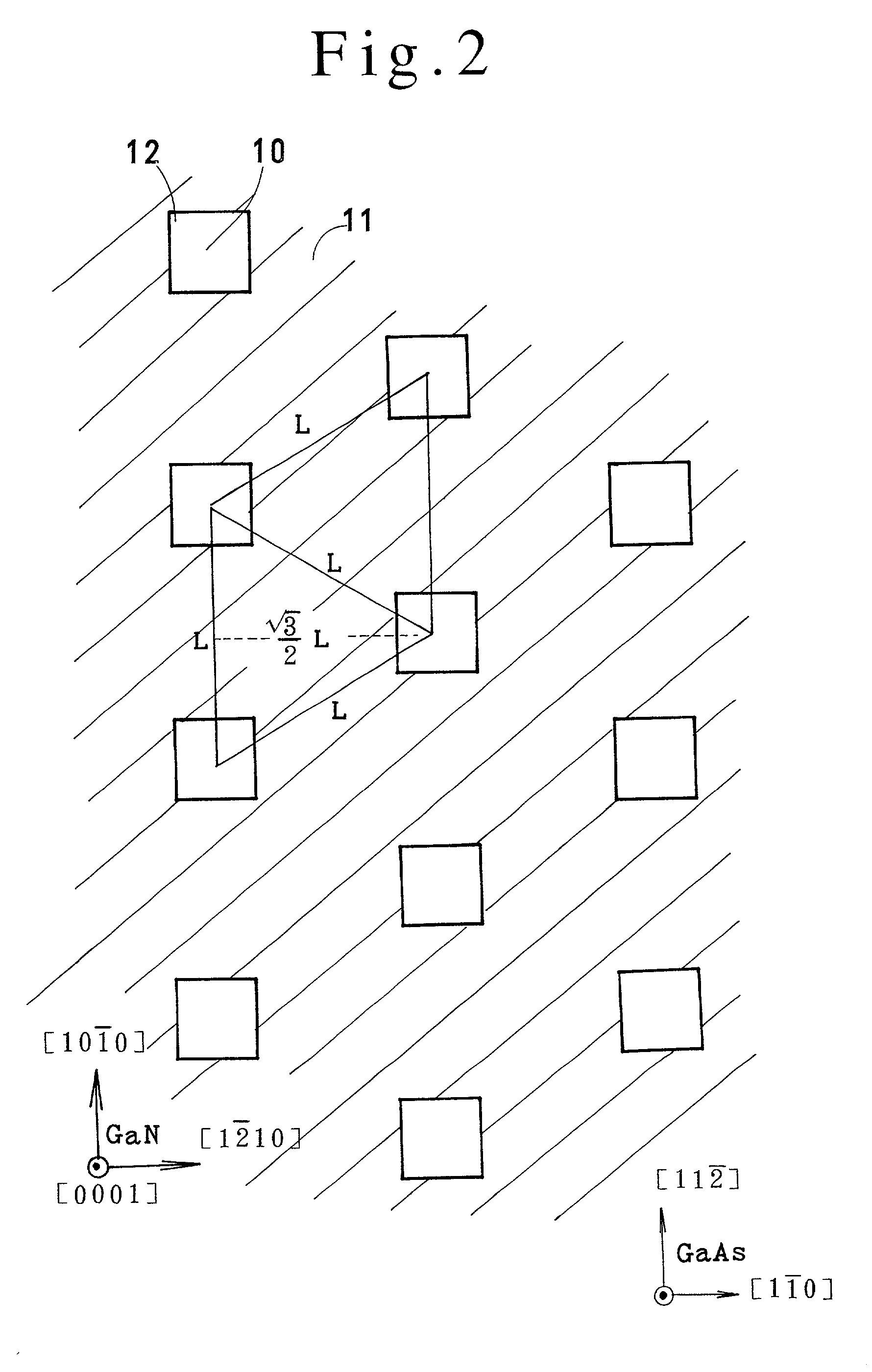Method of producing a single crystal gallium nitride substrate and single crystal gallium nitride substrate
- Summary
- Abstract
- Description
- Claims
- Application Information
AI Technical Summary
Benefits of technology
Problems solved by technology
Method used
Image
Examples
embodiment 1-d
[0319] (EMBODIMENT 1-d) HVPE Apparatus
[0320] The GaAs substrate with the window-carrying mask is laid upon the susceptor 4 in the furnace 1 of the HVPE apparatus as shown in FIG. 1. The HVPE apparatus is designed to be suitable for a long time growth. A GaN freestanding substrate requires a long time growth of GaN.
[0321] The Ga-boat 2 and the susceptor 4 are heated by the heater 6. The Ga is molten in the Ga-boat 2. A mixture of H.sub.2 and HCl gas is supplied to the Ga-melt 3 through the gas inlet 7. Another mixture of H.sub.2 and NH.sub.3 gas is replenished to a space above the susceptor 4 in the furnace 1.
[0322] HCl gas with a carrier H.sub.2 gas is supplied to the Ga-melt heated at about 800.degree. C. Reaction of HCl with Ga makes gallium chloride (GaCl) vapor. The GaCl vapor flows downward near the heated GaAs substrate 5 and reacts with ammonia gas NH.sub.3. The reaction synthesizes GaN. GaN molecules are piled upon the heated GaAs substrate 5. Piling of the GaN makes GaN iso...
embodiment 1-e
[0323] (EMBODIMENT 1-e) Formation of GaN Buffer Layers
[0324] The HVPE apparatus makes about 80 nm thick buffer layers upon the revealed surface of the GaAs substrate within the windows under the condition,
1 Growing temperature about 500.degree. C. (about 773 K) NH.sub.3 gas partial pressure 0.2 atm (20 kPa) HCl gas partial pressure 2 .times. 10.sup.-3 atm (0.2 kPa) Growing time 30 minutes layer thickness 80 nm.
[0325] The mask SiO.sub.2 has a function of rejecting piling of GaN. No GaN film is deposited on the mask. Since the buffer layers (80 nm) are thinner than the thickness (100 nm) of the mask, the buffer layers are enclosed by the window walls and are separated from other buffer layers by the mask material. The buffer layers which are synthesized at a low temperature (500.degree. C.) play the role of alleviating the misfit of the lattice constants between GaN and GaAs.
embodiment 1-f
[0326] (EMBODIMENT 1-f) Formation of GaN Epitaxial Layers
[0327] A thick epitaxial layer of a 3 cm is further grown on the buffer layer and the mask under the condition,
2 Growing temperature about 1020.degree. C. (about 1293 K) NH.sub.3 gas partial pressure 0.3 atm (30 kPa) HCl gas partial pressure 2 .times. 10.sup.-2 atm (2 kPa) Growing time about 180 hours layer thickness 3 cm.
[0328] The process (FIG. 4(2), FIG. 4(3) and FIG. 4(4)) is done at a high temperature. It takes a long time to grow the 3 cm tall GaN epitaxial layer. The growing direction is a c-axis direction. Namely, the surface of the growing crystal is a (0001) C-plane. The GaAs substrate is eliminated by etching with aqua regia. A freestanding GaN single crystal ingot is obtained. A GaN ingot which has been grown in the c-direction is named "c" after the growing direction. The GaN ingot is a first generation c-grown ingot. Thus the GaN is denoted by "c.sub.1". The suffix designates the generation number.
[0329] Electro...
PUM
 Login to View More
Login to View More Abstract
Description
Claims
Application Information
 Login to View More
Login to View More - R&D
- Intellectual Property
- Life Sciences
- Materials
- Tech Scout
- Unparalleled Data Quality
- Higher Quality Content
- 60% Fewer Hallucinations
Browse by: Latest US Patents, China's latest patents, Technical Efficacy Thesaurus, Application Domain, Technology Topic, Popular Technical Reports.
© 2025 PatSnap. All rights reserved.Legal|Privacy policy|Modern Slavery Act Transparency Statement|Sitemap|About US| Contact US: help@patsnap.com



